High School | Daily Do
Why Don't the Dishes Move?

Crosscutting Concepts Disciplinary Core Ideas Is Lesson Plan NGSS Phenomena Physical Science Science and Engineering Practices Three-Dimensional Learning High School Grades 9-12
Welcome to NSTA's Daily Do
Teachers and families across the country are facing a new reality of providing opportunities for students to do science through distance and home learning. The Daily Do is one of the ways NSTA is supporting teachers and families with this endeavor. Each weekday, NSTA will share a sensemaking task teachers and families can use to engage their students in authentic, relevant science learning. We encourage families to make time for family science learning (science is a social process!) and are dedicated to helping students and their families find balance between learning science and the day-to-day responsibilities they have to stay healthy and safe.
Interested in learning about other ways NSTA is supporting teachers and families? Visit the NSTA homepage.
What Is Sensemaking?
Sensemaking is actively trying to figure out how the world works (science) or how to design solutions to problems (engineering). Students do science and engineering through the science and engineering practices. Engaging in these practices necessitates that students be part of a learning community to be able to share ideas, evaluate competing ideas, give and receive critique, and reach consensus. Whether this community of learners is made up of classmates or family members, students and adults build and refine science and engineering knowledge together.
Introduction
Many magic tricks are applications of science ideas performed with a flourish! The tablecloth trick is no exception. But how does the trick work? In today's task, Why don't the dishes move?, students engage in science and engineering ideas and use the thinking tool of cause-and-effect (crosscutting concepts) to make sense of science ideas about forces. Students use these ideas about forces to explain how the tablecloth and similar magic tricks work.
If you and your students love magic tricks and illusions, don't worry! The explanation of the tablecloth trick phenomenon won't diminish the trick's ability to impress and amaze.
Daily Do Playlist: Newton's Second Law
How do asteroids cross Earth's path? is a stand-alone task. However, it can be taught as part of an instructional sequence in which students coherently build the science idea Newton's second law accurately predicts changes in the motion of macroscopic objects. In this second of three playlist lessons, students begin to make sense of that science idea in the pursuit of the answer to their question, "How do asteroids leave the asteroid belt?"
The Tablecloth Trick
Tell students you saw a surprising phenomenon—a magic trick(!)—that you want to share. Ask students to create a t-chart in their science notebook or on a sheet of paper and label one side notice and the other side wonder.
Play Mat Ricardo's Tablecloth Trick video until you can see a clear image of the two tables like the one at left. Stop the video and ask students to individually record their observations and any questions that arise in their t-chart.
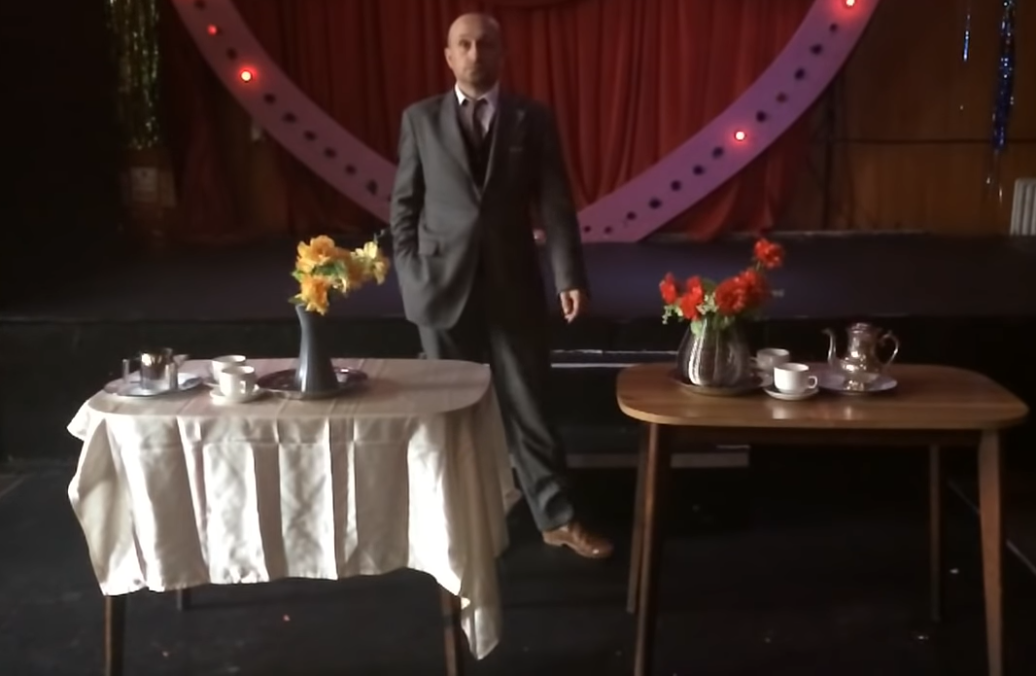
Play the video two or three times while students continue to individually make and record observations. Consider playing the video at half speed (Settings > Playback speed > 0.5) a few times as well. You might also share side-by-side images of the two tables before and after the trick so students can make direct comparisons and record additional observations and/or questions.
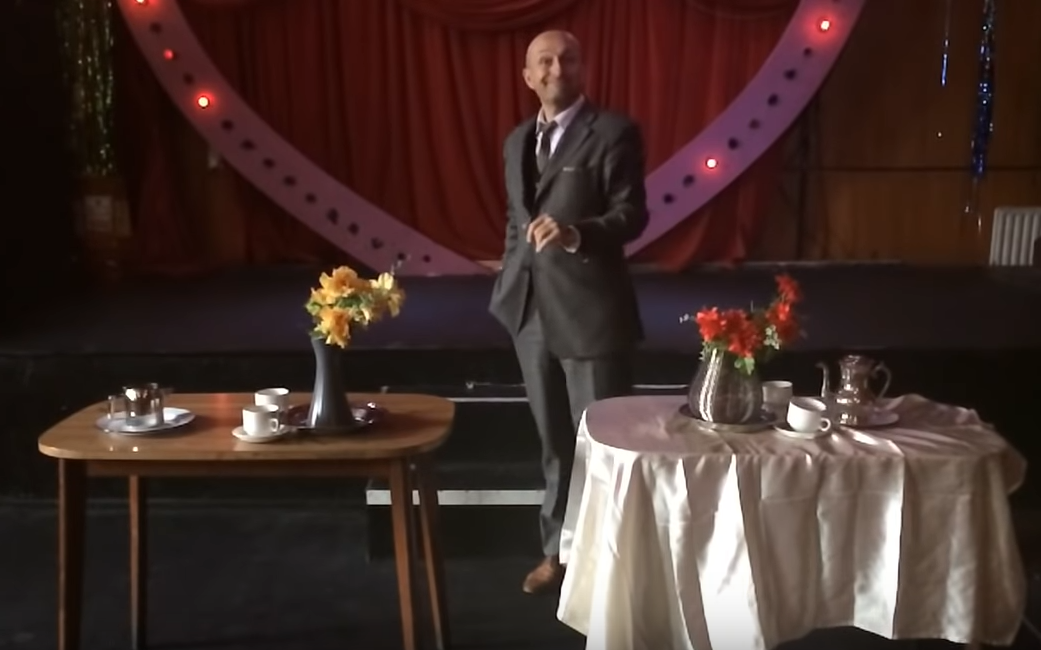
Next, ask students to move into small groups (3 or 4 students) and share their observations. You might use a talking stick protocol (see the Why are plane designs so different? Daily Do) to help ensure each student has an opportunity to share. If you are teaching and learning in a distance-learning environment, consider making a copy and using the Jamboard Notice and Wonder template as a way for students to share their ideas.
Create a class notice-and-wonder t-chart. Ask each group to share two observations that most of the group noticed and one observation that maybe only one student noticed that was an "ooh, I didn't notice that" for everyone else. If a group also shares a question(s), make sure to record their question(s) on the t-chart. Observations and student questions may include these:
- Both tables have dishes, cups, vases, and a coffee/tea pot. Are they all empty?
- Everything on the tables moved. Why did they stay on the table?
- Everything on the tables moved in the direction of the tablecloth. Why didn't the tablecloth drag everything off the table?
- The tablecloth is shiny. Does the type of tablecloth matter?
- The magician pulled the tablecloth. Does how fast he pulls the tablecloth matter?
- Some of the things on the table moved further than others. Why did some things move further than others? Did the things that move further weigh less? Were they empty?
Say to students, "Many of us are wondering why the objects on the table stayed on the table. Does it make sense to investigate this question first?"
Coin in the Cup Investigation
PREPARATION
Materials (per pair of students)
paper card (playing card, stiff index card, etc.)
cup (plastic or glass)
penny
Practice the "Coin in the Cup" trick before performing the trick for your students. Place the card on top of the glass, then center the penny on the card. Quickly flick the card with your forefinger in the horizontal direction (see setup at right).
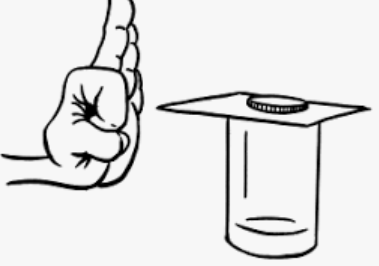
INVESTIGATION
Say to students, "I've seen a phenomenon related to the tablecloth trick that doesn't involve breakable dishes! Let me show you."
Perform the "Coin in the Cup" trick for your students. You might repeat the trick a few times. Ask students, "Do you think we can explain the trick using our knowledge about forces?" Project the first page of the student handout (or redraw on a poster, whiteboard, etc.). Do not distribute to students at this time.
Tell students, "At the start of the trick, what are the forces acting on the penny?" Ask students to turn and talk with a partner first before asking students to share with the whole class. Students will likely say gravity is pulling downward and the card is pushing upward.
Draw an arrow representing the gravity on the top cup. Ask students, "How should I represent the force the card is exerting on the penny? (an arrow of the same size pointing in the opposite direction) Why should the arrow be the same size? (The forces are balanced; there is no net force on the penny; the penny isn't moving.)"
Note: You might choose to label the downward arrow weight and the upward arrow normal force, but students can explain how the trick works without this specialized language.
Next, ask students, "At this moment in the trick (point to middle cup), what are the forces acting on the penny?" Again, ask students to turn and talk with a partner first before asking students to share their ideas with the class. Students will likely say gravity is the only force acting on the penny. (If students mention air, suggest ignoring the effect of air because it is acting on the penny from all directions.)
Draw an arrow representing gravity on the middle cup. Then ask, "At this moment in the trick, what is the motion of the penny?" Students will likely say the penny is moving downward.
You might ask the students to say what forces are acting on the penny at the end of the trick and draw them on the bottom cup (End Position).
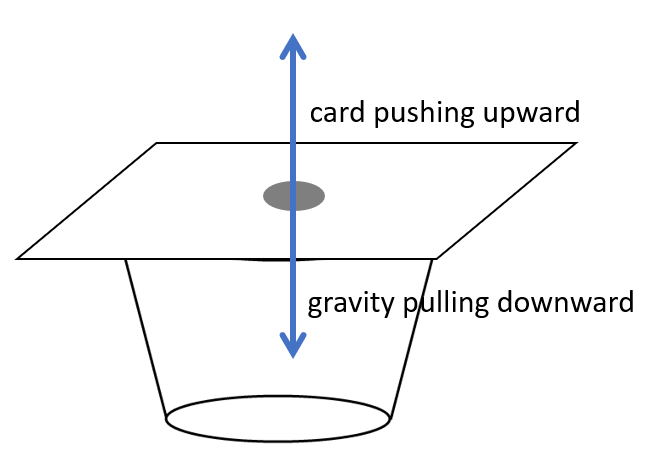
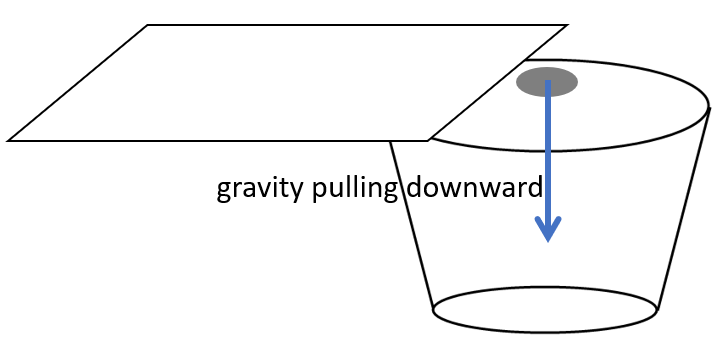
Refer students to the class list of observations, and ask, "Does our explanation of the "Coin in the Cup" trick account for all of our observations?" Use the list to remind students that everything on the tables moved from their starting positions (even though they didn't fall off the table).
Say to students, "Let's see if we can use the materials from the "Coin in the Cup" trick to figure out why the table settings moved but didn't fall off the table."
Give every student a copy of the student handout and distribute materials to pairs of students. Challenge students to alter the trick to achieve each of the three additional desired penny outcomes. Make sure students individually record how they achieved each outcome.
As you move around the room, use questions to keep students thinking about the forces acting on the penny. Some questions you might ask include
- How is the motion of the penny different in this instance from the motion of the penny in the "Coin in the Cup" trick?
- What forces are acting on the penny in this instance? Why do you say so? (If the penny is moving in a horizontal direction, listen for students to account for a force in that direction.)
- What force(s) is acting on the penny in the horizontal direction?
- How is the force acting on the penny in the horizontal direction in this instance (point to an outcome) different from this instance (point to a different outcome)?
Give students time to achieve the desired penny outcomes, but don't worry if not all students achieve all three. Collect all of the materials.
Project the following questions (or write on a poster, whiteboard, etc.) and ask students to answer them in the Alone Zone (independent thinking time).
- Which of the four penny outcomes was closest to what you observed in the tablecloth trick?
- In which case did the card cause the greatest change in the horizontal motion of the penny?
- In which case did the card cause the least change in the horizontal motion of the penny?
- Can you identify a pattern we could use to predict how far the penny will move in the horizontal direction when the card is slid beneath it?
Assign students to groups, and ask them to share their answers to the above questions with the group. Listen for students to share ideas about the amount of time the card applied a force to the penny and the penny's change in motion.
Bring the class back together. Say, "Can we come to consensus on the pattern we could use to predict how far the penny will move in the horizontal direction when the card is slid beneath it?" Ask the group(s) who talked about the amount of time the horizontal force acted on the penny and the penny's change in motion to share their ideas with the class first. To bring the class to consensus, you might ask
- Do we all agree with that? (If students don't agree, ask another group to share their ideas.)
- How are these explanations similar? How are they different?
- What modifications might you make to clarify confusion or address the discontent that this group feels?
- Are there still places in which we disagree? Can we clarify these?
The class will likely reach consensus on the longer the card applies a force to the penny, the further the penny will move in the horizontal direction. Consider sharing the Real Physics of the Tablecloth Trick with students after the class has reached consensus.
Direct students to the class list of observations and questions, and ask, "Which questions have we answered? Which question should we investigate next?" Consider performing the tablecloth trick once the class has figured out the answers to all of the questions!
If you are teaching this Daily Do lesson as part of a playlist, continue to the next section.
Teaching the Daily Do Playlist
Ask students, "How does the knowledge that the longer the card applies a force to the penny, the further the penny will move in the horizontal direction help us explain how Jupiter causes asteroids to leave the asteroid belt?" You might give students time in the Alone Zone (independent thinking time) and ask them to return to their initial model and add to and/or change the part of their model that explains how asteroids leave the asteroid belt (for example, many students may not have included Jupiter as a component and/or interactions between Jupiter and asteroids). Next, ask students to share their revised model with a partner and tell what evidence the addition(s) and/or change(s) is based on. Do not ask students to share their revised models with the class at this time; make sure to tell students you will return to their models later.
To navigate students to the next lesson, you might say, "We figured out the longer the card applies a force to the penny, the further the penny will move in the horizontal direction. Can we reliably use this same pattern to explain the effect Jupiter has on asteroids in the asteroid belt? Should we investigate this next?"
Check Out Previous Daily Dos From NSTA
The NSTA Daily Do is an open educational resource (OER) and can be used by educators and families providing students distance and home science learning. Access the entire collection of NSTA Daily Dos.


